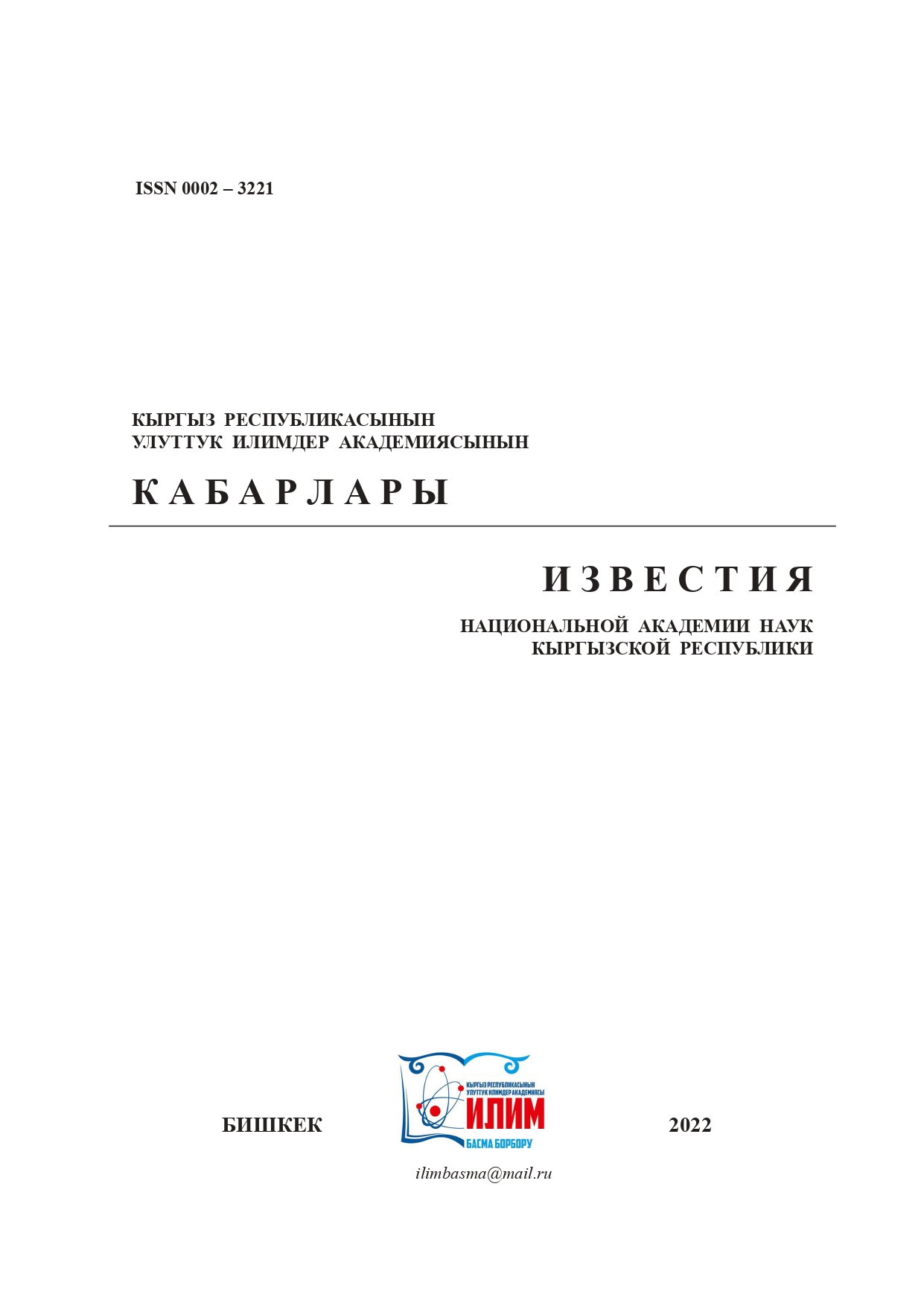POLYMORPHISM OF CHLOROPLAST DNA REGIONS OF SOME SPECIES FROM SCORPIRIS SPACH SUBGENERA (IRIDACEAE JUSS.)
Keywords:
polymorphizm, plastome, Scorpiris.Abstract
The information about the research results of the polymorphic regions of chloroplast
genomes of 4 endemic species from Scorpiris subgenera, namely Juno austrotschatkalica Tojibaev,
F. Karim, et Turgunov, Juno pseudocapnoides Rukšāns, Juno victoris (F.O. Khass., Khuzhan. and
Rakhimova) M.B. Crespo, Mart.-Azorín and Mavrodiev and Iris hippolyti (Vved.) Kamelin, is
presented in this article. The research aimed to detect the most variable regions to use for specific
primer design.
References
Goldblatt P (1990) Phylogeny and classification of the Iridaceae. Ann Missouri Bot Gard 77: 607–627.
Goldblatt P, Manning JC (2008) The Iris family. Natural history and classification. Timber Press Incl, London 290.
Goldblatt P (1991) An overview of the systematics, phylogeny and biology of the southern African
Iridaceae. Contributions from the Bolus Herbarium 13:1-74.
Reeves G, Chase MW, Goldblatt P, Rudall P, Fay MF, Cox AV, Lejeune B, Souza-Chies T (2001)
Molecular systematics of Iridaceae: evidence from four plastid DNA regions. Am J Bot 88:2074-2087.
https://doi.org/10.2307/3558433
Goldblatt P, Manning JC, Rudall P (1998) Iridaceae. In: Kubitzi, K. (Ed.) The families and genera
of flowering plants. Springer, Berlin, Heidelberg and New York 295–333. http://dx.doi.org/10.1007/978-3- 662-03533-7_37
Crespo MB, Martinez-Azorin M, Mavrodiev E (2015) Can a rainbow consist of a single colour? A
new comprehensive generic arrangement of the ‘Iris sensu latissimo’ clade (Iridaceae), congruent with
morphology and molecular data. Phytotaxa 232(1):1-78. https://doi.org/10.11646/phytotaxa.232.1.1
Mavrodiev EV, Martínez-Azorín M, Dranishnikov P, Crespo MB (2014) At least 23 genera instead
of one: The case of Iris L. s.l. (Iridaceae). PLOS One 9(8):e106459. https://doi.org/10.1371/journal. pone.0106459
Wilson CA (2011) Subgeneric classification in Iris re-examined using chloroplast sequence data.
Taxon 60:27–35. https://doi.org/10.1002/tax.601004
Lazkov GA, Sennikov AN, Koichubekova GA, Naumenko AN (2014) Taxonomic corrections and new
records in vascular plants of Kyrgyzstan. Memoranda Societatis pro Fauna et Flora Fennica 90:91–110.
Mathew B. (1989) The Iris, ed. 2. Timber Press, Portland 215.
Tillie N, Chase MW, Hall T (2001) Molecular studies in the genus Iris L.: a preliminary study.
Annali di Botanica (Roma) 1:105–112. https://doi.org/10.4462/annbotrm-9068
Wilson CA (2004) Phylogeny of Iris based on chloroplast matK gene and trnK intron sequence data.
Mol Phylog Evol 33:402–412. http://dx.doi.org/10.1016/j.ympev.2004.06.013
Wilson CA (2009) Phylogenetic relationships among the recognized series in Iris section Limniris.
Syst Bot 34:277–284. http://dx.doi.org/10.1600/036364409788606316
Mavrodiev EV (2010) Is there an alternative treatment of including genus Belamcanda to the genus
Iris (Iridaceae)? In: Shmakov AI. (Ed.) Problems of botany of South Siberia and Mongolia. Proceedings
of the 9th International Scientific and Practical Conference (Barnaul, 25–27 October 2010):148–155. [in
Russian].
Khassanov FO, Rakhimova N (2012) Taxonomic revision of the genus Iris L. (Iridaceae Juss.) for
the flora of Central Asia. STAPFIA 97:174–179.
Souza-Chies TT, Bittar G, Nadot S, Carter L, Besin E, Lejeune B (1997) Phylogenetic analysis of
Iridaceae with parsimony and distance methods using the plastid gene rps4. Plant Syst Evol 204:109–123.
https://doi.org/10.1007/BF00982535
Ikinci N, Hall T, Lledo MD, Clarkson JJ, Tillie N, Seisums A, Saito T, Harley M, Chase MW
(2011) Molecular phylogenetics of the Juno irises, Iris subgenus Scorpiris (Iridaceae), based on six plastid
markers. Bot J Linn Soc 167:281–300. http://dx.doi.org/10.1111/j.1095-8339.2011.01176.x 106 Известия НАН КР, 2022, №7
Kearse M, Moir R, Wilson A, Stones-Havas S, Cheung M, Sturrock S, Buxton S, Cooper A, Markowitz
S, Duran C, Thierer T, Ashton B, Meintjes P, Drummond A (2012) Geneious Basic: An integrated and
extendable desktop software platform for the organization and analysis of sequence data. Bioinformatics
(12):1647-1649. https://doi.org/10.1093/bioinformatics/bts199
Darling AE, Mau B, Perna NT (2010) Progressive Mauve: Multiple genome alignment with gene
gain, loss and rearrangement. PLoS ONE 5(6): e11147. http://dx.doi.org/10.1371/journal.pone.0011147
Tamura K, Stecher G, Peterson D, Filipski A, Kumar S (2013) MEGA6: Molecular volutionary
Genetics Analysis Version 6.0. Mol Biol Evol 30(12):2725–2729. http://dx.doi.org/10.1093/molbev/mst197
Librado P, Rozas J (2009) DnaSP v5: A software for comprehensive analysis of DNA polymorphism
data. Bioinformatics 25(11):1451-1452. http://dx.doi.org/10.1093/bioinformatics/btp187
Benson G. (1999) Tandem repeats finder: A program to analyze DNA sequences. Nucleic Acids Res
(2):573–580. https://doi.org/10.1093/nar/27.2.573
Kurtz S, Choudhuri JV, Ohlebusch E, Schleiermacher C, Stoye J, Giegerich R (2001) REPuter: The
manifold applications of repeat analysis on a genomic scale. Nucleic Acids Res 29(22):4633-4642. http://
dx.doi.org/10.1155/2008/41269610.1093/nar/29.22.4633
Zuker M (2003) Mfold web server for nucleic acid folding and hybridization prediction. Nucleic
Acids Res 31(13):3406–3415. http://dx.doi.org/10.1093/nar/gkg595

